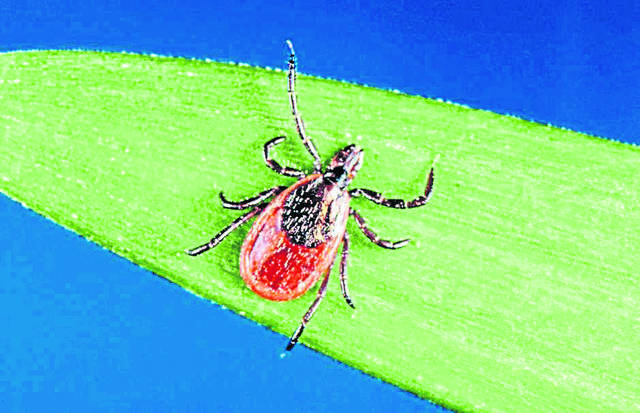May is National Lyme Disease Awareness Month
With the prospect of quarantine measures slowly being lifted across the state in the coming weeks, many Pennsylvanians are relishing the prospect of getting outside and enjoying warming spring weather.
Unfortunately, not only will they have the specter of the coronavirus hanging in the air, they’ll also have tick nymphs hanging at the tips of vegetation, waiting to hitch a ride and sneak a snack.
May is Lyme Disease Awareness Month, and rightfully so, since May starts the nationwide upward trajectory of new Lyme disease cases, which typically peak in July.
Black-legged ticks are in their nymph stage in spring and early summer, which is when the risk of human infection is the highest, according to the Centers for Disease Control.
Pennsylvania is second only to New York state in total number of Lyme disease cases (127,032) reported between 1990 and 2018, according to the CDC.
Below, Amy Wiester of Bell Township spoke with the Trib last fall about her experience with chronic Lyme disease.
The 1990s are significant because Penn State scientists — who looked at 117 years of tick specimens and data submitted by Pennsylvania residents since the early 1900s — think that is when the state’s tick population shifted.
“Before 1990, the majority of tick submissions were identified as ixodes cookei (groundhog or woodchuck tick),” said Joyce Sakamoto, assistant research professor of entomology in Penn State’s College of Agricultural Sciences. “Right now, the dominant species is ixodes scapularis, or black-legged tick, which is the primary vector of Lyme disease. But this tick was almost nonexistent in Pennsylvania in the 1960s.”
In a research paper published last May on the Science Daily website, Sakamoto explained that the black-legged tick’s population likely declined in the early 20th century because timber-harvesting practices such as clear-cutting caused deforestation and destroyed habitat for deer and other wildlife that serve as hosts. As reforestation was achieved and habitat restored in the late 1900s, the population of these ticks — which sometimes are called deer ticks — exploded.
Pennsylvania’s annual Lyme case count did drop according to the most recent state health department data, from more than 11,000 cases in 2017 to just over 10,200 in 2018, but it remains the worst in the nation for Lyme cases, and by a significant margin.
Allegheny, Westmoreland, Butler and Beaver are all among the 10 counties with the highest reported incidents of Lyme disease, along with the rural counties surrounding Philadelphia.
Diagnosis and treatment of Lyme disease is a complicated process, with some patients bouncing from doctor to doctor and spending large sums of money since Lyme symptoms are similar to a host of other illnesses.
Prevention is the best way to avoid a tick bite. See the breakout box for 10 ways to keep ticks away from you and your family.
Tick prevention tips
Here are a few tick-bite prevention tips from Ehrlich Pest Control Entemologist Marc Potzler:
• Dress smartly: If you are going to be outside for an extended period of time, consider wearing long pants, long sleeves and closed-toe shoes. If you are hiking or in wooded areas, tuck your pants into your socks to prevent ticks from crawling up your pant legs.
• Insect repellent: Use an EPA-registered insect repellent while you are outside. We recommend repellent containing DEET.
• Stay away from thick vegetation: Stay in the center of hiking trails and keep your pets from rubbing against brush.
• Lighten up: Light-colored clothing makes it easier to spot ticks.
• Daily inspections: When coming in from the outdoors, inspect yourself, your family and your pets for ticks.
• Keep your yard tidy: Remove weeds and cut grass low. Ticks love to hide in vegetation.
• Regular vet appointments: Maintain routine check-ups for your pets and ask your veterinarian about tick prevention.
• Frequent groomings: Keep your pets safe by maintaining frequent groomings to keep their fur tidy, which makes it easier to spot ticks.
• Professional treatment: Contact a pest management professional to get a tick treatment for your yard.
• Remove the tick: If you have taken these precautions and still spot a tick, use tweezers to gently grab the tick near the head and as close to the skin as possible. Twist to remove it from your skin and disinfect the area immediately. Preserve the tick in isopropyl alcohol and call your doctor immediately. Ticks can also be submitted to the PA Tick Research Lab at East Stroudsburg University, which can be found online at TickLab.org.
Patrick Varine is a TribLive reporter covering Delmont, Export and Murrysville. He is a Western Pennsylvania native and joined the Trib in 2010 after working as a reporter and editor with the former Dover Post Co. in Delaware. He can be reached at pvarine@triblive.com.
Remove the ads from your TribLIVE reading experience but still support the journalists who create the content with TribLIVE Ad-Free.

